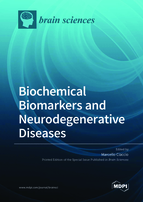Biochemical Biomarkers and Neurodegenerative Diseases
A special issue of Brain Sciences (ISSN 2076-3425). This special issue belongs to the section "Molecular and Cellular Neuroscience".
Deadline for manuscript submissions: closed (15 February 2021) | Viewed by 44783
Special Issue Editor
Interests: multiple sclerosis; neurodegeneration; dementia; vitamin D; cerebrospinal fluid biomarkers; molecular and cellular neuroscience
Special Issues, Collections and Topics in MDPI journals
Special Issue Information
Dear Colleagues,
Neurodegenerative diseases (ND) are a heterogeneous group of disorders characterized by the progressive dysfunction and loss of neurons in different areas of the central nervous system or peripheral nervous system. ND, including Alzheimer’s disease (AD), Parkinson’s disease (PD), and motor neuron disease (MND), represent a big challenge for scientific research due to their prevalence, cost, basic pathophysiological mechanisms, and lack of mechanism-based treatments. The diagnosis, prognosis, and monitoring of such disorders is complex and relies mainly on clinical criteria. In previous decades, biochemical markers, including cerebrospinal fluid (CSF) biomarkers and imaging techniques, such as positron emission tomography (PET) to evaluate brain metabolism, have emerged as promising tools for use in the field of ND.
The aim of the current Special Issue is to present the latest research on the role of biochemical markers in the field of neurodegenerative diseases.
Authors are invited to submit relevant original research articles and review papers.
Prof. Dr. Marcello Ciaccio
Guest Editor
Manuscript Submission Information
Manuscripts should be submitted online at www.mdpi.com by registering and logging in to this website. Once you are registered, click here to go to the submission form. Manuscripts can be submitted until the deadline. All submissions that pass pre-check are peer-reviewed. Accepted papers will be published continuously in the journal (as soon as accepted) and will be listed together on the special issue website. Research articles, review articles as well as short communications are invited. For planned papers, a title and short abstract (about 100 words) can be sent to the Editorial Office for announcement on this website.
Submitted manuscripts should not have been published previously, nor be under consideration for publication elsewhere (except conference proceedings papers). All manuscripts are thoroughly refereed through a single-blind peer-review process. A guide for authors and other relevant information for submission of manuscripts is available on the Instructions for Authors page. Brain Sciences is an international peer-reviewed open access monthly journal published by MDPI.
Please visit the Instructions for Authors page before submitting a manuscript. The Article Processing Charge (APC) for publication in this open access journal is 2200 CHF (Swiss Francs). Submitted papers should be well formatted and use good English. Authors may use MDPI's English editing service prior to publication or during author revisions.
Keywords
- CSF
- imaging
- PET
- neurodegeneration
- neuromuscular disorders
- nuclear medicine
- biomarkers
- Alzheimer’s disease
- Parkinson’s disease
- amyotrophic lateral sclerosis
- diagnosis
- prognosis







